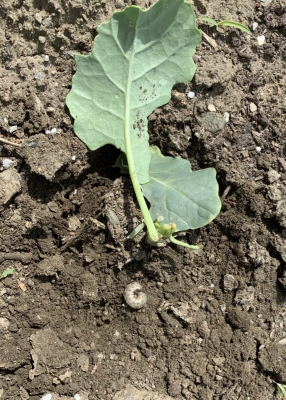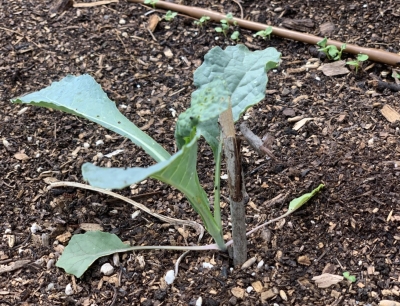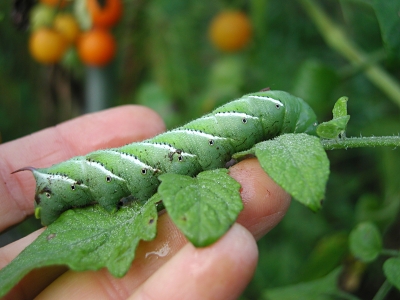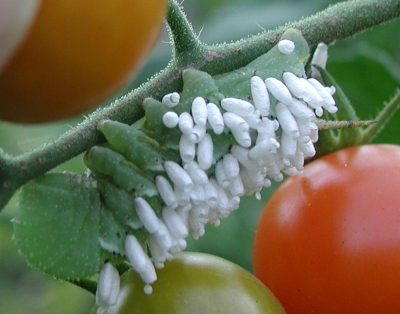Pests Pesky and Not So
Memories
The tumbled over Red Russian kale seedling brought back old memories. It was like seeing the work of an old friend — or, rather, an old enemy. It’s been so long since I’ve seen a cutworm at work in my garden that I couldn’t even get angry at it.

Cutworm and friend’s broccoli
I scratched around at the base of the plant to try and find the bugger. Too late, fortunately for him or her because its fate would then have been a two-finger crush. The cutworm in a friend’s garden I visited last spring was not so lucky.
The bad thing about cutworms are that they chop down young, tender seedlings. At that age, seedlings’ roots lack the energy to grow new leaves; the plants die. (I wonder how the cutworm benefits from lopping back the seedling; the felled plant usually doesn’t get eaten.)

My kale plant
The good thing about cutworms is that, in my experience, they are few and far between — just one or two every few years.
Also, on a garden scale, they’re easy to control, if needed. They prepare for their meal by wrapping their bodies around the plant stems. When I feared them more, I would cut cardboard rolls at the center of paper towels or toilet tissue into lengths of about 1-1/2 inches long, slit one site, fit it around the seedling, press it into the ground, and tape it back closed. A bit tedious, I must admit.
Then I read that cutworms can be fooled. They only attack soft, young seedlings. A thin stick or toothpick slid partway into the ground next to a seedling makes a cutworm think the plant is a woody plant and, hence, out of its league. Since I didn’t find the culprit in my garden, I slid thin sticks next to nearby seedlings. For my friend’s garden, I returned from her kitchen with a handful of toothpicks and instructed her teenage son what to do with them.

Except for today, I haven’t taken precautionary measures against cutworms for many years. Especially every morning, robins, catbirds, and mourning doves are pecking around the ground in my garden; I suspect that’s one explanation for the lack of cutworms.
A Good Parasite
A week or so ago, I saw another old “friend” in the vegetable garden. I noticed that leaflets had been thoroughly stripped from one region of one tomato plant. Obviously, a tomato hornworm, a voracious and rapid diner, was lurking somewhere amongst the existing foliage. A cause for panic? No!
The culprit, a green, velvety caterpillar with widely spaced, thin white stripes and some rows of black dots, is undoubtedly intimidating.

Besides its voracious appetite — you can hear it chomping away — it is the size of an adult pinky.
Still, not to worry. Like cutworms, tomato hornworms turn up in my garden only every few years. And again, like hornworms, they seem to arrive, or show evidence, solo.
I did not reach out to crush the hornworm when I saw her because her back was riddled with what looked like grains of white rice standing on end. Those “rice kernels” are actually the eggs of a parasite that in short order turns that beautiful body to an ugly mush. It’s a dog eat dog world out there.

A Call for Action with This One
I can’t be so complacent about all pests that can turn up in my vegetable garden. Probably the worst one that causes problems every year is one or more of the caterpillars now, as I write, chewing away on the leaves of cabbage and its kin. The symptoms are quite evident: holy . . . whoops, holey . . . leaves upon which is deposited dark green caterpillar poop.
 A close eye is needed on cabbage and its kin because one day there’ll be no damage and next time you look, leaves are riddled with holes and poop.
A close eye is needed on cabbage and its kin because one day there’ll be no damage and next time you look, leaves are riddled with holes and poop.
And then, action is necessary. Hand-picking is one option. I choose to use the biological insecticide B.t., short for Bacillus thurengiensis and commonly sold under such names a Dipel or Thuricide. It should be used with restraint because the insects can — and, in some cases, have — developed resistance to this useful pesticide which is very specific in what it harms and what it leaves alone.
Now that I mention it, excuse me for 10 minutes while I mix up a batch of spray for my cabbages, Brussels sprouts, and kale plants . . .
I’m back. The caterpillars seem to prefer cabbage, Brussels sprouts, and cauliflower over kale, which is fine with me because kale is my favorite of the lot.
Many predators, including certain wasps and beetles, diseases, birds, and bats, keep these caterpillar pests under control. Evidently not enough, though, in my garden.


Lee:
I have very little problem with insects. My problem is with the four leggeg critters. Young bunnies OK . Not much of a problem compared to WOOD CHUCKS!
I have given up trying to grow squash plants , only on my deck and caged.
I am in the process trying to save my tomatoes. I understand ammonia/water/soap solution would defray this creature.
Have you had any problems with wood chucks?
After decades of gardening, never had a woodchuck problem. One reason is outdoor dogs, and I mean outdoors, all the time day and night. Also some amount of fencing. The dogs stay healthy and fit with their outdoor life, and I spend plenty of time out there wit them.
Every year, I get caterpillars of one sort or another on seedlings that are only a few inches high. Left to their own devices, they would destroy the seedling long before they matured, and presumably starve to death next to the stalk they’d killed.
Nature isn’t as smart as we tend to think it is.
She probably is once you know all there is to know.
I’ve long thought that cutworms are mother nature’s ‘thinners’. Many fruits, rotting on the ground, leave lots of seeds in a few square inches. Cutworms kill enough plants to ensure a few thrive.
The ‘rice grains’ on the hornworm’s back are cocoons. A tiny wasp lays her eggs through the caterpillar’s skin, alien style. The eggs hatch and the tiny larva eat the caterpillar’s insides. When fully grown, they chew their way out, and spin those cocoons. We once watched this happen on the kitchen table. Yes, I fed the hornworm tomato leaves while it was in captivity.
Last year a cardinal male and female would light on my tomato cages….look around and fly into my tomato vines to get a tasty snack. No such help this year. I was going out at night with my blacklight flashlight and found 5 (1 on each) but now I spotted 5 little skunks in the shed, they leave the shed and travel through my little garden spot every night….I just don’t want to take a chance on encountering one in the night. I have fixed the shed but I still see them out & about in the area. I was hand pollinating my zucchini flowers because my bees are slackers this year. Only spotted a couple squash bugs which I detest and removed all the leaves that had eggs. So far no more eggs or adults but summer isn’t over yet. Battle of the bugs-it’s a yearly thing. Take care
I find that the cabbage loopers come and go in cycles in my garden. I’m guessing it’s because the wasps do their thing and knock the numbers back following big caterpillar years. This year’s a particularly bad year for them in my garden.
In my area (western Oregon) cutworms can be as devastating as slugs. I planted a ton of peas this year and nearly every one of them was munched down.
Strangely, I haven’t had many pests on brassicas this year. The cabbage butterfly usually inflicts serious damage, and I’ll have to go handpick or spray. But I’ve been spraying off the aphids pretty regularly this year, and I think that may have helped with the caterpillars. I see the butterflies out there regularly and have barely noticed any damage. Perhaps I have another friend helping me out.